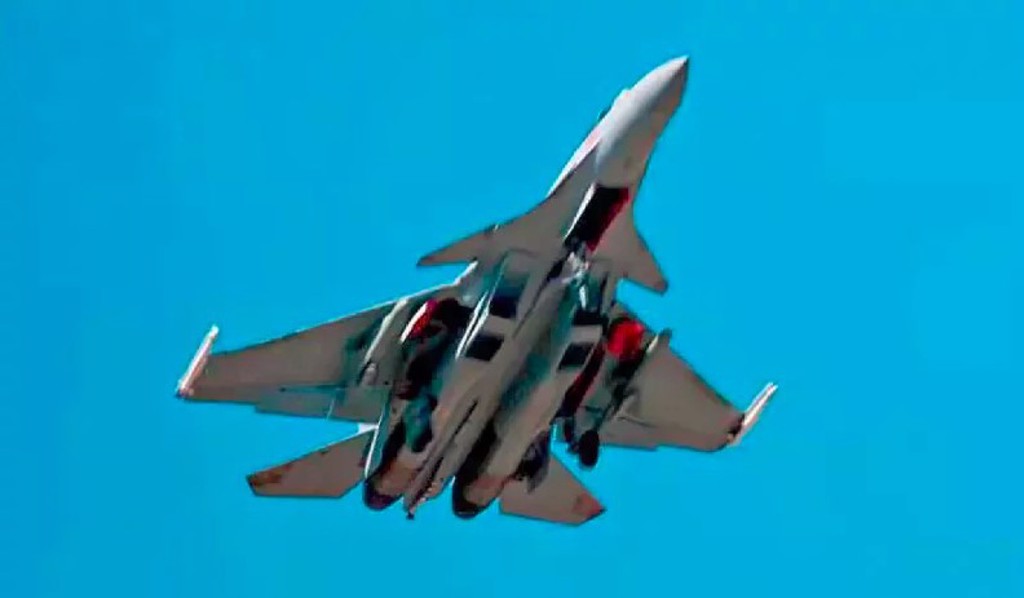On April 23, the official “CCTV” station in mainland China aired a special report on Navy Day. It broadcasted footage of the Communist Party’s stealth fighter jets taking off and landing on the third aircraft carrier, the Fujian ship. It was also recently stated by the official WeChat public account of the “People’s Navy” that the catapult-type J-15T carrier-based fighter jet of the Fujian ship had been painted with “navy grey” and “flying shark” logos, indicating that it has been put into service in batches.
On the 25th, former Taiwanese Air Force lieutenant general Chang Yan-ting pointed out in a television show that the J-15T had been modified in many places to adapt to the electromagnetic catapult of the Fujian ship. It has a wide detection range, fast combat speed, and sizable bomb-carrying capacity.
During the programme, Chang Yan-ting mentioned that the J-15T fighter jet has also been subject to several alterations due to the electromagnetic catapult takeoff used by the Fujian ship. Because it must be ejected, the entire structure needs to be highly robust. A front landing gear with sturdy oblique braces and an ejection rack has replaced the primary landing gear on the aircraft. The pitot tube located on the nose of the plane has been removed, which has made it much simpler to install an upgraded phased array fire control radar in preparation for future battle zones’ potential to be further apart. The electro-optical radar in the front of the nose has a larger aperture and a stronger detecting capability than its predecessor.
Chang Yan-ting further mentioned that the technological advancements and simplified design of the J-15T are geared at increasing the launch rate of the aircraft. Because it uses electromagnetic catapults, the Fujian ship can launch a fighter plane in as little as one minute into the future. Launching a fighter jet from the aircraft carriers now in use takes at least three to five minutes. Shandong and Liaoning aircraft carriers must be adjusted for specific parameters before launching an aircraft from their deck.
Chang Yan-ting emphasised that the Fujian ship’s use of electromagnetic catapults for takeoff means engaging in combat will be very fast.

Image: official WeChat account of “People’s Navy”
Chang Yan-ting also pointed out that because the electromagnetic catapult does not require a ski jump, the J-15T’s payload will increase. With a larger payload, the firepower and combat power will also be stronger, posing a significant threat to the eastern part of China in the future. The People’s Liberation Army (PLA) army must deploy ahead of time and carefully consider how to adjust the operational structure to respond to the enemy.
Chang Yan-ting emphasised that because the Fujian ship uses electromagnetic catapults for takeoff, engaging in combat will occur rapidly. Zhang Yanting also pointed out that the electromagnetic catapult does not require a ski jump, increasing the payload that the J-15T can carry. The greater load will result in more firepower and enhanced fighting power.
J-15 carrier-based fighter
According to the Russians, China replicated one of the prototypes of the Su-27K (Su-33), the experimental aircraft TYUK-03, which it purchased from Ukraine in 2001, according to other sources in 2005.
Chinese media, citing representatives of the country’s aviation industry, assert that the J-15 is not a direct copy of the TYUK-03 aircraft but rather a modification of the J-11B fighter (modified copy of Russian Su-27) created using individual elements of this aircraft, which received a brake hook and several other carrier-based aircraft elements.
According to media reports, six aircraft of the J-15 type dubbed the “Flying Shark,” had already participated in flight tests by September 2012. The CFTE Centre (China Flight Test Establishment) is located at the Yan Liang airbase near Xian and is responsible for evaluating the takeoff of a fighter from the deck. On the Center’s property, a takeoff ramp was constructed with dimensions and layouts comparable to the ramp used by the Varyag Aircraft Carrier. According to reports, the first series of J-15 aircraft consists of sixteen units. While J-15A was an experimental aircraft, the production model was called J-15B.
On September 25, 2012, the Vyrag-converted Liaoning aircraft carrier officially joined the PLA Navy. On November 4, 2012, the PLA Daily, a PLA press organ, reported that a J-15 fighter aircraft ran over the Liaoning’s deck before taking off. The first five successful landings of J-15 fighters on an aircraft carrier were officially declared on November 25, 2012.
The information and control characteristics of the J-15 cockpit, which is equipped with multifunctional liquid crystal displays, are identical to those of the J-11B cockpit. The armament of the carrier-based fighter consisted of Chinese-designed high-precision weapons, such as PL-8 and PL-12 air-to-air missiles and YJ-83K anti-ship missiles.
A two-seat carrier-based combat training aircraft with the J-15S designation made its inaugural flight on November 4, 2012.
The Chinese media leaked information regarding testing a new variant of the J-15 carrier-based fighter in November 2020. According to the media, the Shenyang J-15T carrier-based fighter could launch using a catapult from an aircraft carrier’s flight deck. The new aircraft features numerous technologies of the fifth generation that are used on the latest J-31 fighters. The media even claims that the Chinese WS-10 engine has replaced the Russian AL-31F engine.

